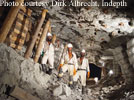

A pioneering new project aims to develop a small, low cost, autonomous robot which can enter hazardous underground environments, gather data and provide feedback on the potential risks before miners enter the area.
The CSIR’s Centre for Mining Innovation (CMI), together with National Instruments, recently hosted a symposium on mobile robotics. Delegates were given an insight into CMI’s Underground Autonomous Mine Safety Platform which is currently under development.
This is a robotic platform which supports the technology needed to develop small, low cost, autonomous robots capable of navigating through the stopes of gold mines. Current work is focused on the development of a robot which can evaluate the condition of hanging walls underground to prevent injuries and deaths caused by rock falls.
This is based on the temperature differential between stable and unstable areas. The robot will navigate along a narrow stope carrying an infrared thermal sensor to detect loose rock as cold spots. The stope will be fitted with ultrasonic beacons and the robot will be equipped with a receiving device for localisation as well as a time-of-flight camera for composing a 3D map of the rock face. Together these will monitor the hanging wall, delineate the high risk zones, and indicate them on a risk map.
This is the precursor to the development of a comprehensive mining system that will be able to mine reefs that are currently too narrow for economic exploitation, thereby unlocking marginal deposits.
Many challenges
The challenges are considerable and there are a number of technologies which will be developed. These include localisation; electric rock breaking; robotic control of the rock breaking tool; power source supply and management; and further down the road swarm robotics and reef tracking using laser spectroscopy to ensure that the robot is mining ore and not host rock.
The immediate problems to be addressed by the project are localisation and mapping.
Stope navigation in a GPS-deprived environment
Accurate location information is needed for robot navigation in the muddy, steep, high slip environments typically found underground, but localisation is difficult because there is no GPS. To overcome this, an ultrasonic, time-of-flight beacon system has been designed to enable the mining robot to localise itself in the stope environment.
Sonic beacons will be mounted on the end of roof bolts in the excavations and transmit a 40 kHz ultrasonic signal and a 2,4 GHz radio signal simultaneously. The receiver, mounted on the robot platform, calculates the difference in time-of-flight for the two signals and uses this information to compute the distance of the robot from the beacon. Triangulation of the signals from multiple beacons with known position will allow the robot miner to determine its position accurately. Essentially the sonic beacons create an underground GPS system.
Mapping
A time-of-flight camera will be used to generate a 3D map of the area while the robot localises itself relative to the map. The camera operates by measuring the time for light to leave the camera, reflect on the hanging wall and return. This gives the distance from the camera of each individual pixel or data point in the image. The localisation data will enable the wall condition measurements to be superimposed on this map. From this a safety map can be constructed and an entire area can be inspected before miners re-enter the mine after a blast.
A new niche
Robotics is still a fledgling research area in South Africa and the severe environments found underground present major challenges for the successful operation of mining robots. An autonomous mining robotic safety platform for stope inspections as well as search and rescue operations is a niche application where South Africa could make a significant contribution both to robotics research and the mining industry.
For more information contact Jeremy Green, CSIR, +27 (0)11 358 0084, [email protected], www.csir.co.za

© Technews Publishing (Pty) Ltd | All Rights Reserved